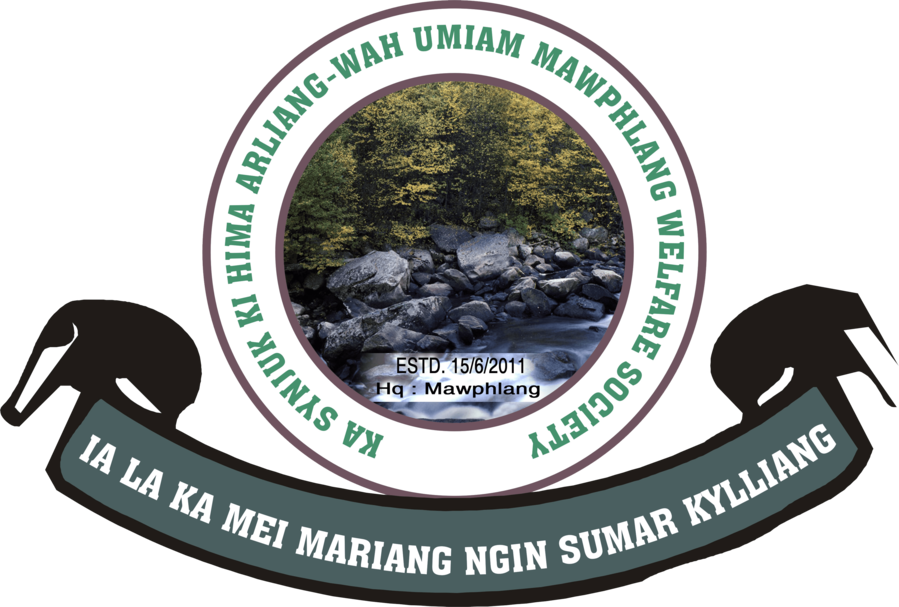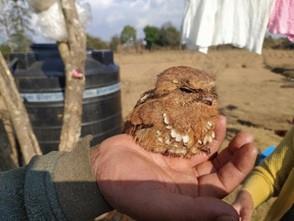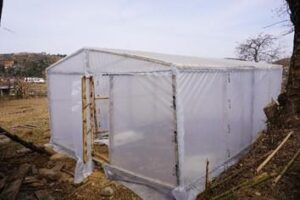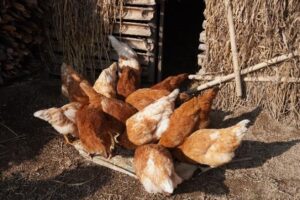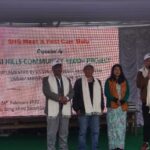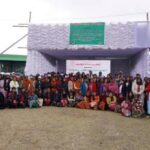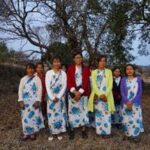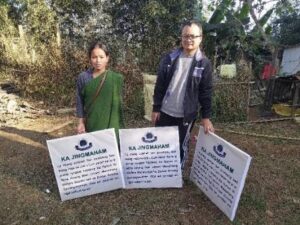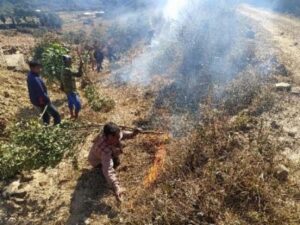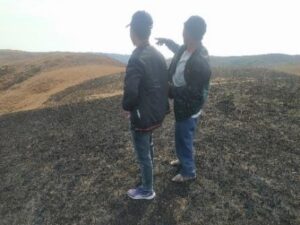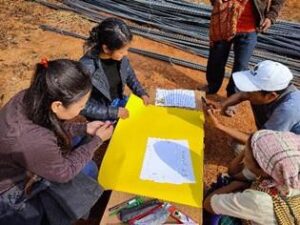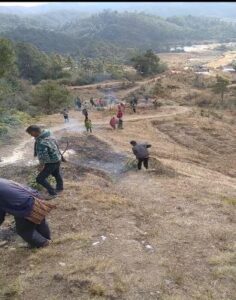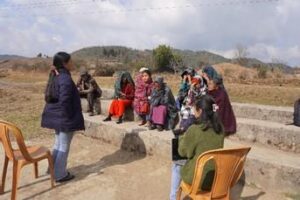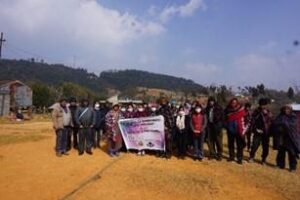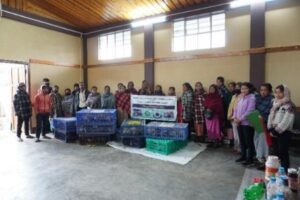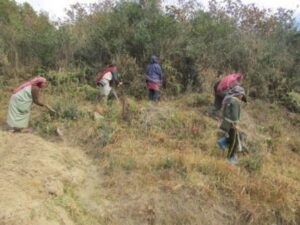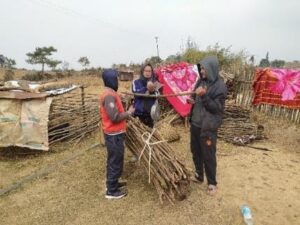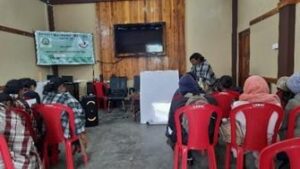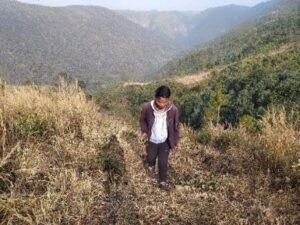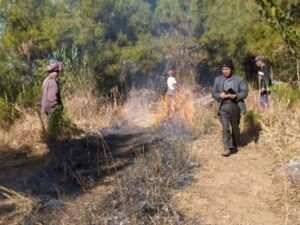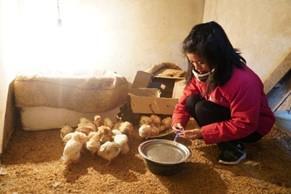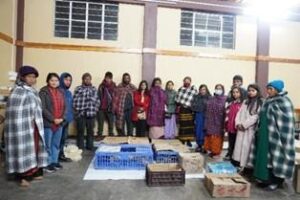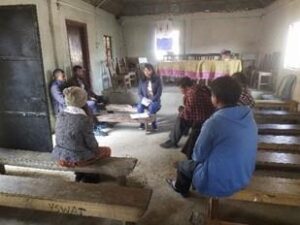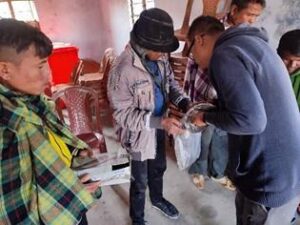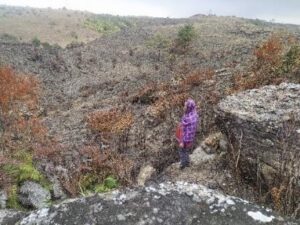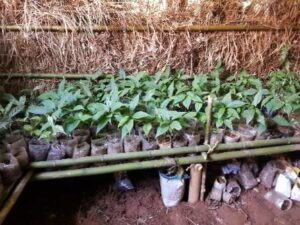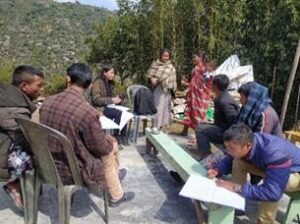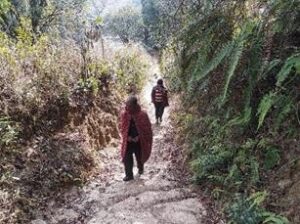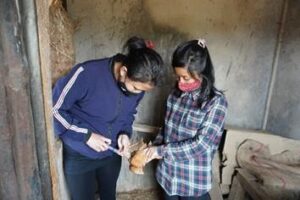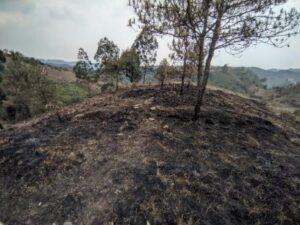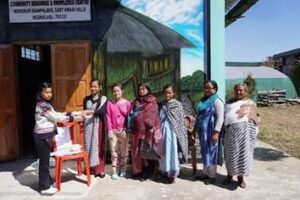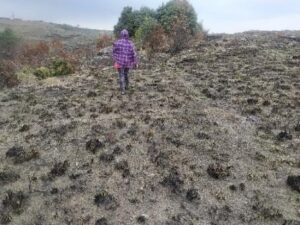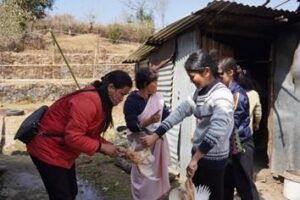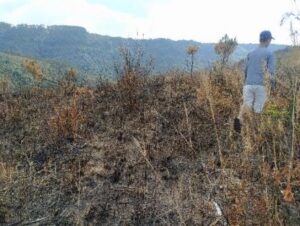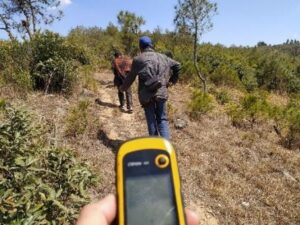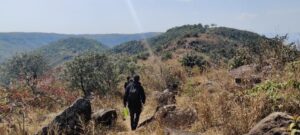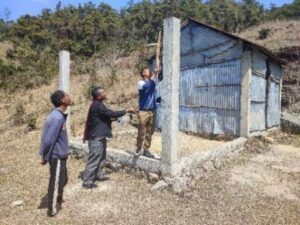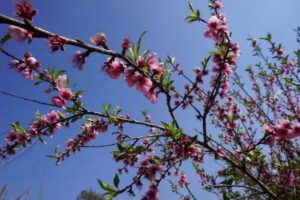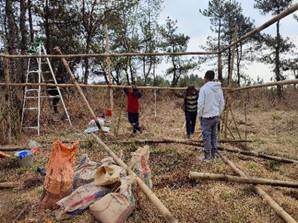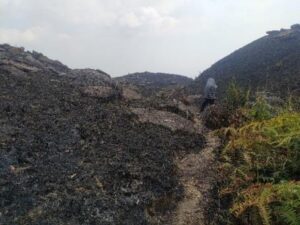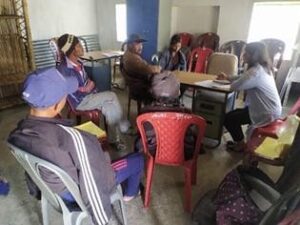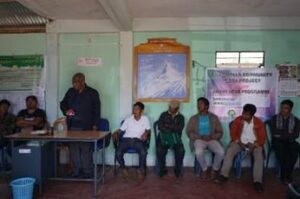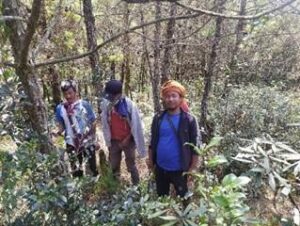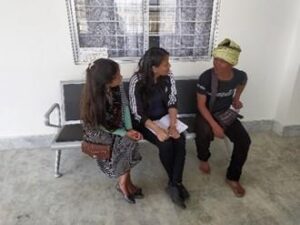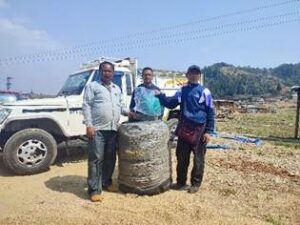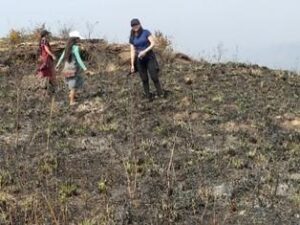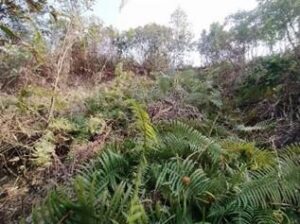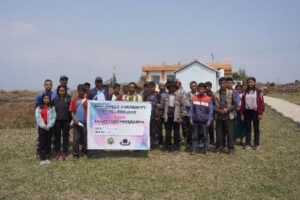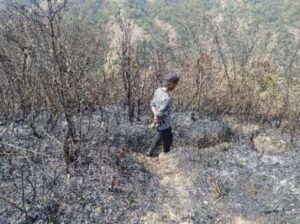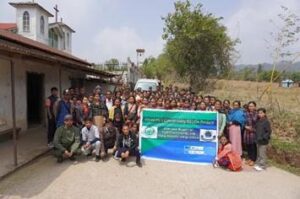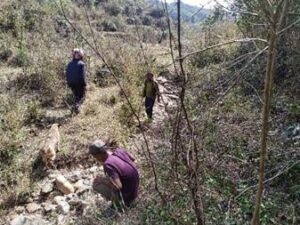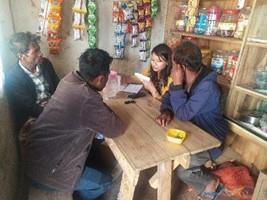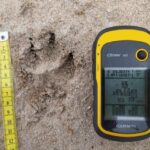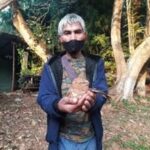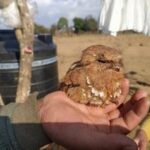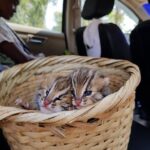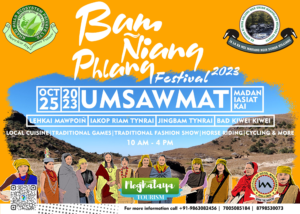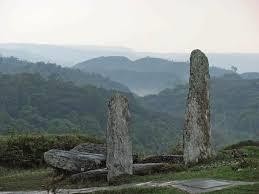
KHASI HILLS COMMUNITY PROJECT
1st Quarter Report PV 2022
PROJECT SUMMARY
The Khasi Hills Community REDD+ Project has completed 10 years of successful operation. The project has mobilized over 7,250 families to protect and restore 2,847 hectares of old- growth, montane cloud forests in the Umiam River Watershed. In addition, project communities are working to regenerate over 9,000 hectares of degraded forest. In return for their efforts to save their community forests from logging, forest fires, mining, and conversion to agriculture, the project provides communities with a diverse set of social and economic activities. The project is reaching its goal of increasing household income as new village surveys show that 70 percent of the families are below India’s poverty line, compared to early project numbers of 90 percent. The project also seeks to improve public health through the provision of clean drinking water systems and smokeless cooking technologies, such as LPG and rice cookers, to reduce household air pollution.
Response to COVID-19 Global Pandemic
The COVID-19 pandemic has decreased in Meghalaya and throughout India. During the first three months of 2022, the Covid cases had dropped significantly down to no new cases over several days. Community facilitators and youth volunteers have continued with forest patrols, monitoring, and fire monitoring. The team has also been busy conducting awareness programmes, training programmes, site visits, and preparing for the upcoming planting season. There are currently no restrictions in place and travel to the state has opened again to tourists. The team continues to take precautions and stays up to date on best practices.
Forest Habitat and Wildlife Conservation
Conserving the montane cloud forests along the steep banks of the Umiam River is a major goal of the project. The dense forests drop over 500 meters to the rushing waters of the river which subsequently flows into Bangladesh. The historic David Scott Trail constructed in the early 19th century, winds its way up the river gorge and has become a popular hiking route and tourist destination. Forest conservation is complemented by community efforts to restore forest fragments on the hill tops above the river, creating a wildlife corridor that extends from the 2,000-meter plateau down to the Bangladesh plains. This habitat supports a broad range of birdlife, reptiles, and mammals, as well as amphibians, fish, and orchids, some of which are found only in this area. During this quarter, several species were sighted in the project area including an owl, migratory birds, and leopard prints. Two stranded leopard cubs were also rescued by project community members.
Awareness programmes continue to be held in villages on a regular basis. During these programmes, the socio-economic team, forestry team and project director speak on the project activities and the benefits provided toward communities for conservation of forests and habitats. The village Headman and the Community Facilitators often lead the discussion and provide a platform for the project to communicate with community members.
An important project strategy to reduce deforestation and forest degradation is community- based forest fire control. The project has continued to train local Community Facilitators in monitoring the production, transport, and use of charcoal within the project area. This first quarter is characterized by the dry season, during which fires are prominent. Several of the fires were caused by charcoal production which spread into the project area and by burning weeds for agricultural production. The team and Community Facilitators measured an area of 76 Ha (23 Ha of which was grassland) that had been affected by fire from January to March 2022. During these months, youth volunteers and community members in the project area were active in making and maintaining over 77 km in length of fire line in order to protect forests from fire. Continuing awareness programmes are being implemented to raise awareness on fire safety throughout the communities and reduce the spread of forest fire.
Degraded Forest Restoration
With nearly 9,000 hectares of degraded forest land, the project seeks to restore these areas to improve wildlife habitat, increase the hydrological function of the watershed, and sequester atmospheric carbon. Each participating village identifies the degraded community forests that they want to restore and agrees to close the land to firewood collection, grazing, and agriculture. 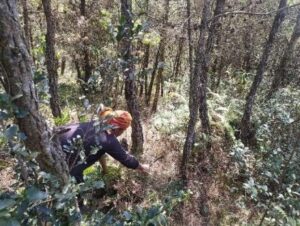 The villages receive support from the project to clear fire lines, remove weeds and scrub, coppice and pollard trees to promote growth, and open space for emerging saplings through siliviculture activities. Many of these activities take place during these first quarter months when it is the dry season. Gaps are filled with seedlings and saplings once the rains begin later in the year. Currently there are approximately 1,640 hectares of land being actively restored with Assisted Natural Regeneration (ANR) treatment.
The villages receive support from the project to clear fire lines, remove weeds and scrub, coppice and pollard trees to promote growth, and open space for emerging saplings through siliviculture activities. Many of these activities take place during these first quarter months when it is the dry season. Gaps are filled with seedlings and saplings once the rains begin later in the year. Currently there are approximately 1,640 hectares of land being actively restored with Assisted Natural Regeneration (ANR) treatment.
Clean Energy Transition
Household firewood consumption for cooking and heating is a major driver of deforestation in the project area as well as contributing to indoor smoke pollution that causes respiratory illness. In addition, fuelwood burning also is a major source of carbon emissions. To address these problems, the project is working to supply all project families with LPG cooktops, LPG cylinders, or electric rice cookers. Previous surveys by the team found that adoption of gas cooktops has reduced firewood consumption an average of 2.5 kgs of fuelwood per day for each household. Fuelwood usage has been monitored by youth volunteers during this quarter.
To get a better understanding of how families use fuel currently, including fuelwood and charcoal, the project is conducting ongoing surveys based on fuel needs and current arrangements. Through the surveys, the team found that those who had used the LPG found it to beneficial in cooking time and ease. However, one of the challenges is the distance and cost of refilling the cylinder. The surveys will also provide information on which families are already implementing LPG or rice cookers and which would like to do so in the future. The CFs play an important role in monitoring and following up on alternative energy practices.
Sustainable Agriculture
With most families dependent on farming for their income, improving agricultural practices has been a project priority. The project team seeks to assist families from a heavy dependence on low value potato cultivation to diversify into horticulture, polyhouse and shadenet vegetable growing, and organic farming. This year one SHG is developing their own design for a polyhouse using locally available bamboo. The socio-economic team will continue to monitor the structure for improvements or to implement similar designs elsewhere in the project area. During this quarter one of the farmers’ clubs was cultivating mustard leaves, cauliflower, and radish within the shade net. Profits of shade net beneficiaries ranged from Rs. 4000 to 6000.
The project has also started training interested farmers in buckwheat cultivation. This is a high value and fast growing crop which has many health benefits known to the local people already since there is a wild variety which has been used for food and medicine over the years. The crop can also be planted among fruit trees and is beneficial to soil health as well.
SHGs are also involved with vermicomposting to increase value-added products to their marketable goods and for use in their own agricultural practices. During this quarter a training on vermicomposting was conducted with 17 participants and vermicompost systems were revitalized with the necessary amendments for new production. The project distributed 900 chicks to 45 beneficiaries in February, vaccinations were given following distribution, and some SHGs sold their grown chickens at Rs.1000 per chicken.
Eco-Tourism and Cultural Conservation
During the 1st quarter, the newly appointed Tourism Development Specialist continued to conduct a number of capacity building programmes including a training on mountain bike safety and maintenance.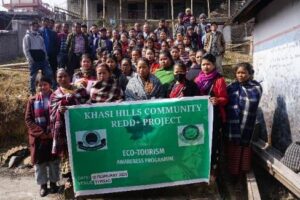 Through the previous awareness programmes the project team was able to bring the ideas of the core features of tourism to the community members: Attraction, Accommodation, Accessibility, Activities, Amenities, and Affordability. The team has also been able to inventory and assess the potential tourism sites and has created a composite index table for base-line information on tourism related features of the communities. These features include infrastructure and support systems; economic interactions; and social interactions of hospitality, safety, and security. This data will help indicate where the gaps are in advancing tourism throughout the project.
Through the previous awareness programmes the project team was able to bring the ideas of the core features of tourism to the community members: Attraction, Accommodation, Accessibility, Activities, Amenities, and Affordability. The team has also been able to inventory and assess the potential tourism sites and has created a composite index table for base-line information on tourism related features of the communities. These features include infrastructure and support systems; economic interactions; and social interactions of hospitality, safety, and security. This data will help indicate where the gaps are in advancing tourism throughout the project.
Community Horticulture
As part of the project’s sustainable agriculture program which includes organic farming techniques, vermiculture, and composting the project team is also providing high value fruit trees such as peach, plum, pear, apple, kiwi, and pomegranates to project families. This helps diversify farm produce, especially low value potato farming on which many families depend. Fruit trees also provide produce that can be converted to value-added jams, pickles, or dried fruit. The fruit trees are found to have a high survival rate when protected from grazing animals and winter frost. During this quarter, fruit trees continued to be monitored by the Community Facilitators. This is also the season for many of the temperate fruit trees to bloom, however there was a very cold winter in much of the state and several hail and wind storms which may have damaged some of the trees.
Mushroom Cultivation
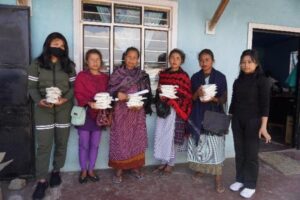 The project continues to oversee a mushroom cultivation programme and has been expanding this high value production system given the conducive moist, high elevation environment. Oyster mushrooms bring in a good return for local families once the mushroom house has been constructed.During this quarter, one of the beneficiaries has continued to purchase spawn with the profit she has made from harvesting 15 kg of mushrooms at Rs. 200/kg. The project also distributed mushroom spawn to 46 beneficiaries from 9 of the Hima.
The project continues to oversee a mushroom cultivation programme and has been expanding this high value production system given the conducive moist, high elevation environment. Oyster mushrooms bring in a good return for local families once the mushroom house has been constructed.During this quarter, one of the beneficiaries has continued to purchase spawn with the profit she has made from harvesting 15 kg of mushrooms at Rs. 200/kg. The project also distributed mushroom spawn to 46 beneficiaries from 9 of the Hima.
SHG FEDERATION
The project is currently in the process of forming an SHG Federation to improve and overcome the inherent limitations of small and informal groups, like limited resources, capacity, negotiation and bargaining powers and an inability to deal with the outside world such as Government, mainstream institutions, and markets. The project team has been organizing several awareness programmes about the Federation of SHGs. Lady Community Facilitators are also spreading awareness about the SHG Federation while meeting with SHGs in their respective Hima. During this quarter, the socio-economic team also held an SHG Meet and Fest/Mela where SHGs were awarded for best performance and were able to sell their goods to one another and to guests.
Community Development Grants
Each year the project provides the participating communities with community development funds to finance projects that benefit many village families. The villages prepare proposals for priority projects. The villages are defining their proposals and planning to carry out the projects in the year ahead. The CFs met with the LWC members to discuss these projects and ensure that they are moving forward once funds are released. Most communities use the funds for sanitation, community water resources, solar lighting, eco-tourism, and school upkeep.
Project Updates
- January 2021
- February 2021
- March 2021
6 January 2022
The Forestry Team supplied signboards for the ANR at Synrangshohnoh, Hima Mawbeh. Along with the Asst. CF of Hima Mawphlang the Forestry Team inspected the eco-tourism site before the inauguration at Ramklang, Hima Mawphlang.
8 January 2022
Firelines were monitored at Remjumai, Pamsanngut, Hima Pamsanngut along with the CF of Hima Pamsanngut. The length of the firelines was 2 km.
11 January 2022
The Socio-economic Team (SET) monitored a new design for the polyhouse of Baniaineh SHG at Phanniewlah village. The materials used were polythene, bamboo, cement, zig zag wire, crushed rock, sand, and rope. The polyhouse has been completed. After monitoring, the team went to Mawsawrit, Hima Pamsanngut to inspect the bee colony of Mr. Stu Rynjah.
11 January 2022
The area of forest fire at Umsawmat, Hima Lyngiong was measured along with the Asst. CF and Headman of Umsawmat village. Approximately 10 Ha was affected, and the cause was unknown.
12 January 2022
The project team organized an awareness programme at Kyllapongti village along with the village headman and the CF. After the programme, the SET conducted Participatory Rural Appraisal (PRA) to gather information through village led mapping and the participation of the community people.
13, 14, 18 January 2022
Firelines were measured and monitored at multiple locations along with the CFs, Asst. CFs, and local Youth Volunteers. At Khlaw Remdong the length of the firelines was 2 km. Firelines at Umsawmat village, Hima Lyngiong were also measured to be 2 km. Firelines at Ranab Mawblei, Mawsawrit, Hima Pamsanngut were measured to be 1.2 km complete.
20 January 2022
The SET organised an awareness programme on the Federation of SHGs at Nonglwai village, Hima Nonglwai. There were 11 attendees during the programme including 6 SHGs. The programme was chaired by the Lady CF of Hima Nonglwai.
1 February 2022
The project team organized an awareness programme at Mawponghong village of Hima Lyngiong. After the awareness programme, the SET conducted PRA with the community people. The techniques that were used are social mapping, resource mapping and Venn diagram.
2 February 2022
The SET distributed layer chicks to Hima Mawphlang, Hima Nonglwai, Hima Lyngiong, Hima Nongspung, Hima Nongspung, Hima Pamsangut and Hima Nongspung. Each Hima had 5 beneficiaries, each beneficiary received 20 chicks. A total of 600 chicks for 30 beneficiaries was distributed.
2 and 3 February 2022
The Forestry team monitored the fireline of 3.3km at Phanniewlah- rum, Hima Lyngiong with the Asst. CF and youth volunteer of Hima Lyngiong. The Forestry Team monitored 1.5 km of fireline at Lumphotmawngap, Laitmawpen, Hima Mawphlang along with the Asst. CF of Hima Mawphlang.
3 February 2022
The Forestry Team monitored the fuelwood at Laitmawpen, Hima Mawphlang along with the Asst. CF and youth volunteers of Hima Mawphlang.
3 February 2022
The SET conducted training on vermicomposting at the Community Resource and Knowledge Centre. There were 17 participants who attended the training. The training was given by Ms. Saralin Lyngdoh who explained the steps to make vermicompost.
5 February 2022
The Forestry Team along with the CF of Hima Mawbeh monitored silviculture activity on 2.5 Ha at Lumphari ANR, Synrangshohnoh, Hima Mawbeh.
5, 8, 11, and 14 February 2022
The Forestry Team monitored fireline activity of 1km at Synrangshohnoh, Hima Mawbeh along with the Asst. CF of Hima Mawbeh. The Forestry Team monitored 5.2km of fireline at Sohlangbet ANR, Thainthymroh, Hima Lyngiong with the Asst. CF and youth volunteer of Hima Lyngiong. The Forestry team monitored 3.2 km of fireline at Laitmawhing, Hima Lyngiong along with the Asst. CF and youth volunteer of Hima Lyngiong. The Forestry Team along with the CF of Hima Laitkroh monitored 3.5 km of fireline at Law Adong Laitkynsew, Hima Laitkroh.
8 February 2022
The IBD vaccination was given for layer chicks that had been distributed on the 02/02/2022 at Hima Mawphlang, Hima Lyngiong, Hima Nonglwai, Hima Mylliem.
9 February 2022
The SET distributed layer chicks to Hima Laitkroh, Hima Mawbeh, Hima Sohra. Each Hima had 5 beneficiaries and each beneficiary received 20 chicks. A total of 300-layer chicks were distributed to 15 beneficiaries.
16 and 17 February 2022
The Forestry Team met with the headman of Hima Nongspung area for the Village Management Plan at Tyrsad Umkseh. The team also met with the Sordar of Ladmawphlang and Laitsohpliah of Hima Sohra regarding the same.
16 February 2022
The Home-based Nursery training was held at Syntung village. Participants from two villages, Syntung and Mawlang, were called for the training. 10 participants were present on the day. After training, the team also distributed seeds of Taxus baccata and Alnus nepalensis to participants.
23 February 2022
The Forestry Team measured the forest fire at Siat U Rai ANR, Mawkma, Hima Sohra with the Asst. CF of Hima Sohra. The total burnt area was 7 Ha.
24 February 2022
The SET organized the 6th Self Help Group (SHG) Meet and Fest cum Mela product sale under Khasi Hills Community Redd+ Project, implemented by Ka Synjuk Ki Hima Arliang Wah Umiam Mawphang Welfare Society. There were 191 attendees during the programme which included speeches by the Founding Chairman, the Ranger Forest Officer of the Wildlife Division, the Block Development Officer, and the Treasurer of the Synjuk. 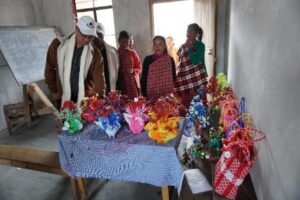 The guests spoke on conservation of biodiversity and the importance of the SHGs in the work of the project. Awards were given to the best performing LWCs, SHGs and Farmers Clubs. The groups also sold their products including indigenous food, clothing, soaps, utensils, and handlooms following the programme.
The guests spoke on conservation of biodiversity and the importance of the SHGs in the work of the project. Awards were given to the best performing LWCs, SHGs and Farmers Clubs. The groups also sold their products including indigenous food, clothing, soaps, utensils, and handlooms following the programme.
25 February 2022
The team monitored the HBN of Malum Tyrsad village. The team found that the nursery was well maintained and had a high survival rate of saplings. The team also provided the nursery with seeds to increase the sapling number and diversity.
25 February 2022
The LWC meeting was held at Lawkhla Mawlong, Hima Nongspung. Action on the Village Management Plan was discussed with the headman of Lawkhla, Lawkhla Mawlong, Wahrisain and Laitniangtlong village.
26 February 2022
The Forestry Team mapped the village area of Mawponghong, Hima Lyngiong with the Asst. CF of Hima Lyngiong and Headman and Secretary of Mawponghong village.
1 March 2022
The Socio-economic Team (SET) administered the R2B vaccination to the layer chicks which were distributed on 02/02/2022 at Hima Mylliem, Hima Pamsanngut, and Hima Nongspung.
1 March 2022
The Forestry Team along with the CF of Hima Pamsanngut monitored the forest fire at Mawramhah, Pamsanngut. The measurement came to 0.7 ha.
2 March 2022
The SET distributed mushroom spawn to 46 beneficiaries from Hima Mawphlang, Hima Nonglwai, Hima Lyngiong, Hima Nongspung, Hima Pamsanngut, Hima Laitkroh, Hima Mawbeh, Hima Sohra, and Hima Nongkhlaw.
2 March 2022
The Forestry Team monitored and measured the fire at Mawmihthied Community Forest, Hima Sohra. A total of 20 ha of grassland area was affected.
3 March 2022
The SET administered the R2B vaccination to the layer chicks which were distributed on 02/02/2022 at Hima Mawphlang, Hima Nonglwai and Hima Lyngiong
3 March 2022
The Forestry Team along with the Asst. CF of Hima Mawphlang monitored and measured the fire at Lumthangkanam Forest, Hima Mawphlang. The area affected was 1 ha.
5 March 2022
The Forestry team along with the CF of Hima Laitkroh monitored the fireline length of 3.5 km and the silviculture activity of 6 ha done at Law-Adong, Laitkynsew, Hima Laitkroh.
5 March 2022
The Forestry Team visited Mawbri village for mapping of the site.
8 March 2022
The Forestry team visited Remdong village to inspect the site for the construction of a school under the Special Grant.
8 and 9 March 2022
The SET monitored the temperate fruit trees during the flowering season in Hima Lyngiong, Hima Pamsanngut, and Hima Mylliem. The team found that some of the trees which had been distributed several years ago were damaged by the cold winter and heavy frost.
9 March 2022
The Forestry Team visited Laitthemlangsah village for data collection and measurement of the polyhouse for the installation of agronet.
9 March 2022
The Forestry Team along with the Asst. CF and Youth Volunteer of Hima Lyngiong monitored and measured the fire at Lumdidum, Lyngdoh Phanblang, Hima Lyngiong. A total area of 20 ha was measured.
10 March 2022
The Forestry Team visited the Headmen of the villages (Mawstep, Pyrda, Jathang, Rngidiengsai, Kukon, and Mawbri) under Hima Sohra for the action on the Village Management Plan.
10 March 2022
The Project, in convergence with the Krishi Vigyan Kendra (KVK), East Khasi Hills, Shillong, organized a training on buckwheat cultivation. The Socio-Economic Specialist, Ms. Ibadapbiang Lyngdoh Kynshi, along with the trainees attended the training conducted by Scientist, Sir Bansharai Syiemlieh. The Scientist gave a practical on how to cultivate buckwheat in the project area.
10 March 2022
The Project Director along with the Forestry and Socio-economic Teams organized an awareness programme at Raid Madan Kyrdem, with 18 village headmen attending.
15 March 2022
The Forestry Team along with the Asst. CF of Hima Mawbeh monitored the silviculture activity of 0.5 ha at Lumiarain, Synrangshohnoh, Hima Mawbeh.
17 March 2022
The Forestry Team met with the Headman of Umdiengpoh village, Hima Sohra to discuss the Village Management Plan.
17 and 18 March 2022
The Forestry Team disbursed materials for home based nurseries in the Project area at Tyrsad and Mawjrong. See table below for items disbursed.
18 March 2022
The Forestry Team along with the CF of Hima Sohra monitored the fire at Sohrarim. The team measured a total grassland area of 3 ha that was affected.
21 March 2022
The Forestry Team along with the CF and Asst. CF of Lyngiong monitored the silviculture activity of 3 ha at Umsawmat, Hima Lyngiong.
22 March 2022
The project team organized and conducted an awareness programme at Pashang Village. There were 26 village council members who attended from 8 villages.
22 March 2022
The Forestry Team along with the CF and Asst. CF of Hima Mawbeh measured the forest fire at Hima Mawbeh. A total area of 2.3 ha had been engulfed by fire at Lumjingtep and Law Adong, Mawbeh.
25 March 2022
The project team organized an awareness programme in Mawsadang village to reduce the spread of forest fire and to educate the communities on harmful fishing and hunting techniques in order to protect the biodiversity within the project area. There were 80 participants who attended the programme.
26 March 2022
The Forestry Team monitored silviculture activity of 3 ha area at Khlawshnong, Nongthymmai Rum, Hima Lyngiong with the Asst. CF of Hima Lyngiong.
28, 29, and 31 March 2022
The Forestry Team had meetings with the Headmen of Thainthynroh, Lawshlem, Kyndong Laitmawbah, and Nongthymmai rum villages of Hima Lyngiong discuss the Village Management Plans.
Biodiversity Monitoring
In January 2022, an injured nightjar species was found by Mr. Jelishon Mawlong of Nongwah village, Hima Pamsanngut and handed over to the Wildlife Dept. of Meghalaya. During the same month footprints of a wild animal were recorded at Lum Kyrphei, Hima Mylliem. The footprints were found to be that of a leopard species. In March 2022, the Forestry Team received information that two leopard cat cubs were found stranded in the wild. They were handed over to wildlife services.
